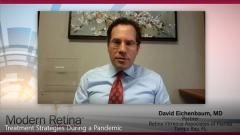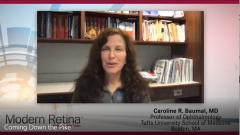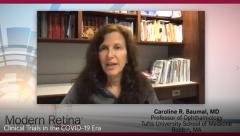
Treatment Strategies During a Pandemic
Episodes in this series

David Eichenbaum, MD: Let's go onto some discussion about patient demographics. Tell me, Caroline, what does the typical treatment-naive patient look like now at Tufts New England Eye Center in 2020 when they come in for their first wet macular degeneration diagnosis and treatment?
Caroline R. Baumal, MD: People know that we can treat neovascular AMD, that we're able to get patients in earlier, but there's still a subset of patients that all of a sudden just notice sudden vision loss, and they'll come in very late. I would say the average patient that I see comes in with a visual acuity between 20/60 and 20/80, but there is the occasional patient who comes in with acute vision loss, or all of a sudden, they covered one eye and realized that they weren't seeing from their other eye. These are the patients that we really want to get to because studies have shown us that earlier treatment leads to a better prognosis and a better outcome when possible.
Dr. Eichenbaum: I feel if someone said, ‘What are your patients seeing when they come in?’ I’d say oh, I have a patient who’s someone in their 70s, and they’re seeing 20/40, 20/50 when they come in. They're probably more like 20/63, 20/80.
We'd like to catch them earlier for the reasons that you said, but they're certainly coming in sooner than they used to, if we look at the size of the lesions and the more modern studies like HAWK and HARRIER versus MARINA and ANCHOR, or VIEW 1 and VIEW 2. The lesions are now smaller and the visual acuities that are being allowed in the studies are a little bit better, so we're doing better.
But I think you're right, we're still catching them in real life with somewhat advanced disease plus these patients seem to have a lot of comorbidities. They’re COPD patients. They’re vascular patients. They’re urology patients. They’re GI patients. They have these diseases of aging —They fall or what have you.
How has that impacted your practice during the pandemic era with the patients who are dependent on frequent injections for disease that presents at a moderately advanced stage who are nervous about coming in because of their comorbidities? Have you seen those patients do worse when they come back now after missing a shot?
Dr. Baumal: That's a really important thing to take into consideration, and I’ve seen patients who've come in with recurrent disease and more fluid that had been previously controlled. There are definitely patients who've come in that have lost vision, and I think that we'll find as a profession that this pandemic led to a setback in some people's treatment.
Even during the height of the pandemic there were some motivated patients that did come in, and I would say that I learned to really tailor their visits to getting them the treatment as efficiently as I could in the office, so they didn't have to stay too long and be concerned. I was able to bring patients in directly. Sometimes if imaging wasn't necessary, we didn't do that. I would see the patient just in one room, do their examination and treatment, and make the appointment for follow-up with the patient right in the room so they were able to leave directly. I think that this level of efficiency made my patients feel much more comfortable to come in during the pandemic.
Dr. Eichenbaum: Did you reschedule your wet AMD patients during the pandemic? Did you move them out or did you encourage them all to keep their appointments?
Dr. Baumal: There was a lot of chart reviewing, which I know that you and many of our other colleagues have done, looking at our regular patients’ charts, looking at their images, calling them on the phone, asking them if they had any changes on their Amsler grid to try to determine whether they could be delayed a few weeks. There are some patients I have that just need to be injected frequently, every 4, 5, 6 weeks, and when we've tried to extend them in the past, they've recurred. Those patients I did call and talk with them and try to see if they wanted to come in, if they felt safe, and then we would expedite their injection. Any patient that could be extended a little bit, for their comfort I did do that.
Dr. Eichenbaum: I was a little more nervous about my wet AMD patients. In other disease states I certainly did push them off, but my wet AMD patients, typically I brought them in for injections, and I made a lot of the modifications that you just mentioned. I made the visits quick. We did some injection-only at the last fluid-free interval. We already had a process for undilated injections. We've done bilateral injections for a long time, but I encourage the wet AMD patients to come if they could because it's a less forgiving disease state than some of the other disease states that we control with at the anti-antiangiogenics.
Dr. Baumal: I found that my patients were extremely grateful that we were there during the pandemic, during the height of things in Massachusetts, there and available and willing to change the way we do things to get them their treatment. They all were so thankful, thanking me and the office staff for coming in to take care of them. I feel the majority of people were not afraid, and just really wanted to get their eyes treated and go home.
Caroline R. Baumal, MD: Hello and welcome to this discussion presented by Modern Retina and Ophthalmology Times titled, “Treating Age-Related Macular Degeneration in 2020. I'm Dr. Caroline Baumal. I'm a Professor of Ophthalmology at Tufts University School of Medicine in Boston. Please welcome—okay.
Please join me in welcoming my colleague, and not only my colleague but an ex-fellow from Tufts and a good friend of mine, Dr. David Eichenbaum, who is currently a partner at Retina Vitreous Associates of Florida in Tampa Bay. In today's discussion we'll talk about available therapies and some that are still in development as well as practical considerations in treatment of wet AMD during the post-pandemic era.
Newsletter
Keep your retina practice on the forefront—subscribe for expert analysis and emerging trends in retinal disease management.


















































